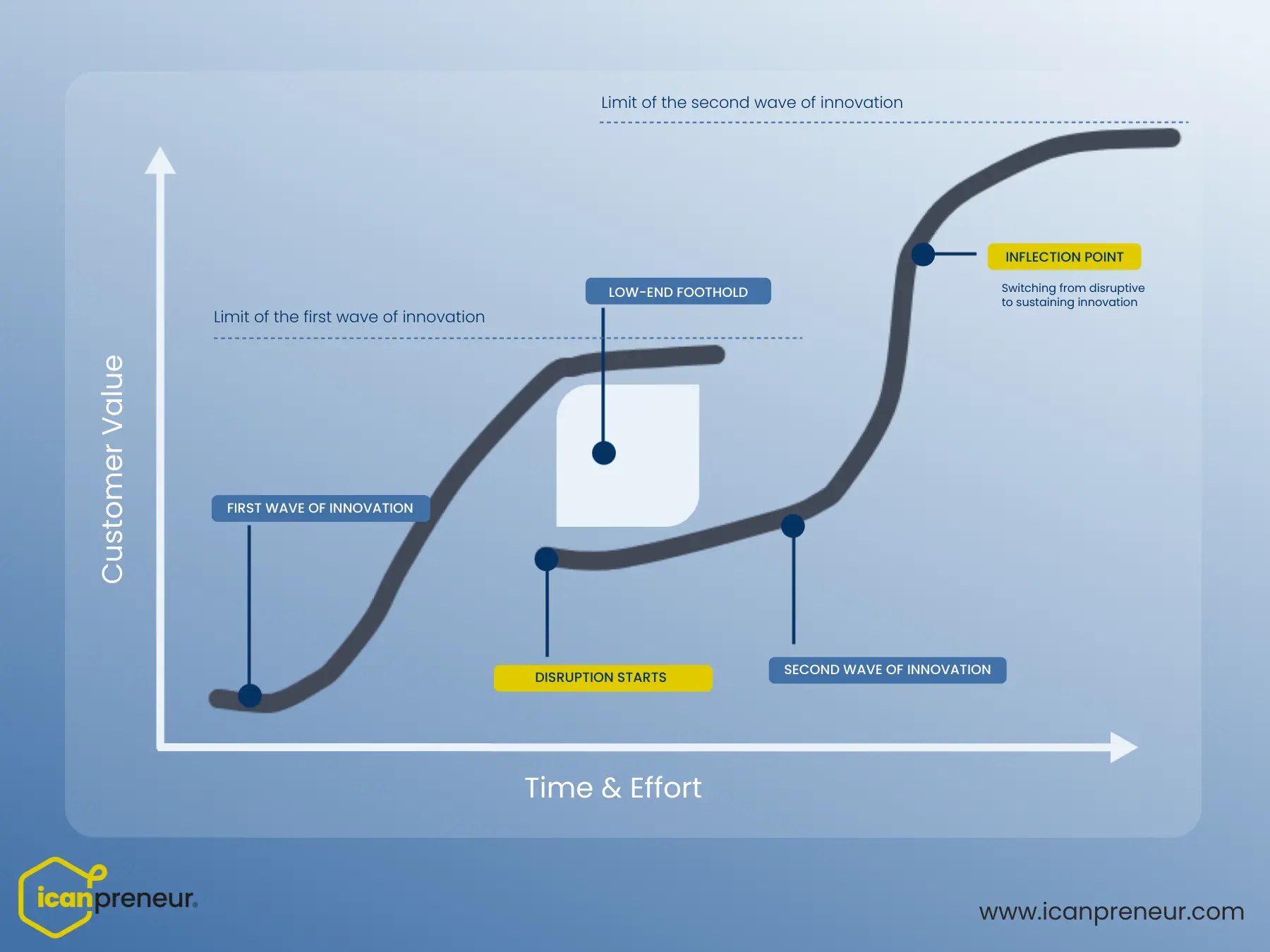Sustaining vs Disruptive Innovation: The Perfect Balance
Aug 23, 2024 • 7 min read
Sustaining Innovation Definition
Sustaining innovation is improving existing products or services, focusing on increasing the customer satisfaction of the existing customer base. This type of innovation adds incremental improvements to their products to address the evolving needs of existing customers.
Sustaining innovation is more than just a retention strategy. It helps market leaders retain their leadership position by constantly increasing the value they deliver to customers.
It also protects established incumbents from competitors who try to win the market by following the market leader's example. A strong innovation strategy is an excellent unfair competitive advantage.
Sustaining Innovation Examples
Toyota’s Hybrid Engine
Toyota’s hybrid cars are a great example of sustaining innovation. By enriching its fleet with hybrid options, Toyota addresses consumers' growing expectations for higher efficiency and reduced environmental impact.
While early adopters are already switching to electric vehicles, the mainstream market still relies on traditional combustion engines. Adding hybrid technology allows consumers to use products they are comfortable with and still addresses their evolving needs.
Tesla’s Over-the-Air Update System
Model S by Tesla added an OTA update mechanism that unlocked a new avenue for sustaining innovation. Unlike traditional car companies that rely on service campaigns and mainly minor updates, Tesla can update almost any software aspect of its cars. OTA updates allow much more value to be delivered post-purchase in the long term.
Microsoft Office Suite
The office suite has been one of Microsoft's most impactful revenue streams. The product's first version dates back decades and ran on ancient operating systems.
Over time, the office applications improved significantly, adding cloud integration, real-time collaboration, version history, and more.
Disruptive Innovation
Disruptive innovation focuses on winning a new market by offering a product that addresses the underserved needs of a niche customer segment better than the current alternatives at a more affordable price. The lower price often comes with lower quality or other compromises. Customers readily make these tradeoffs in favor of the new product's advantage.
Developing disruptive technologies is an excellent strategy for a company to:
- penetrate a new market,
- displace current established markets,
- create a new market altogether.
Disruptive Innovation Example
Revolut
Revolut is a neobank and a fintech company, a great example of disruptive innovation. Revolut challenged traditional banks by focusing on very specific customer segments:
- Frequent travelers,
- Tech-savvy millennials,
- Expatriates,
- Great mobile application, which is the only interaction point.
For these specific groups, the company offered some excellent services that traditional banking solutions didn’t or couldn’t provide:
- No fee payments to other users (which also creates a strong network effect)
- Attractive currency exchange rates
- Completely online registration and onboarding process
Revolut lacked many other offerings that the mainstream customer expects:
- Credit cards
- Loan and deposits
- Mortgage
However, it hit the bullseye for its target segments, which didn’t care enough about the missing products. Revolut grew rapidly in functionality and user base with strong initial traction and a viral network effect. In terms of valuation, it now competes with the biggest banks in Europe.
Sustaining Innovation vs Disruptive: Key Differentiators
The digram below illustrates how disruptive and sustaining innovaiton play together to create continuous waves of innovation.

Product Quality
Product quality is a key difference between sustaining and disruptive innovation. Sustaining innovation strives for better products with higher quality. On the other hand, disruptive innovation starts with products of worse quality but solves one problem very well for a specific customer segment.
That difference comes from who you are targeting. When working with an existing user base, consumers have certain expectations for your product. Shipping a new iteration with weaker quality will result in unhappy customers.
When working with a new user base, the company is freed from previous expectations. To succeed, it must excel in one area.
Business Model
Another difference between the two types of innovation is what’s up for change. Sustaining innovation works within the boundaries of the existing business model. Disruptive innovation has the opportunity to create a new business model, and this is a great strategy for innovating.
The business model is often deeply engrained into the product experience and value proposition. A subscription-based business model, for example, will have one way of acquiring, activating, engaging, and retaining customers. A one-time purchase product will have a completely different strategy.
Sustaining innovation involves stepping on existing products, and one cannot switch to a different model without completely revisiting the product experience. Disruptive innovation, on the other hand, starts from a blank sheet of paper and has that opportunity.
Target Audience
As mentioned, sustaining innovation focuses on existing customers, while disruptive innovation targets new customers. This fact creates a very different dynamic in the product development process.
Sustaining innovation has multiple sources of information from customers that need to be captured, synthesized, and acted upon. Changes in existing products always have to weigh in the risk of:
- jeopardizing existing revenue streams,
- cannibalizing own products,
- not disrupt relationships with customers, partners, and vendors.
Sustaining innovation usually has a straightforward go-to-market path that builds on the existing product delivery stream.
Disruptive innovation must consider the go-to-market strategy as part of the product development process to ensure that the value the product creates gets to the target users. Relationships with consumers and partners are yet to be built, so that’s rarely a concern. When disruptive innovation happens in a startup, existing revenue, and products are also an issue.
Target Market
In terms of markets, sustaining innovation addresses the current market for the product to expand it. It offers more value and addresses the needs of an increasing number of consumers.
Disruptive innovation tackles a new market, specifically a very narrow segment of it. While sustaining innovation aims to retain market position, disruptive innovation displaces established companies.
Valuable Lessons from the Downfalls of Major Industry Players
While sustaining innovation can greatly expand the lifespan of a product and provide companies with longer runaway, it won’t last forever. Sooner or later, market leaders will be challenged, and when unprepared, they can be displaced in an instant.
Nokia
Not so long ago, Nokia was the market leader in the mobile phone market. They kept innovating with the operating system, new models, better displays, etc.
However, when the iPhone came, it had:
- a big touchscreen,
- no keyboard,
- a completely new operating system with a delightful user experience.
Nokia was utterly unprepared to respond.
As a result, they quickly lost their market share to the iPhone and multiple Andoird-based phone manufacturers. The article "The Real Cause of Nokia's Crisis," published in Harvard Business Review, captures very well the root cause and consequences of Nokia’s failed innovation strategy.

Sega
Sega started as a gaming company that produced coin-operated arcade games for American troops in the 1940s. It quickly became the market leader by creating better hardware machines that supported more engaging games.
Sega successfully transitioned to home game consoles in the 1980s. Its bestseller, Super Sonic, made Sega a giant in the gaming industry.
A decade later, a new chapter of console wars started when Sony created the PlayStation. Sega was unprepared to transition from primarily a hardware company to one that innovated through software and games. Premium consoles innovated through newer and better games rather than shipping hardware.
One thing led to the other, and Sega was quickly displaced from its leadership position in the game console market. They ultimately left this market.
Yahoo
In its earliest days, Yahoo was a dominant player in the internet space. It offered:
- excellent web portals,
- a search engine,
- various online services.
Yahoo kept investing in sustaining innovation by offering more services like mail, news, blogging platforms, etc.
Challenged by Google and Facebook in the mid-2000s, Yahoo started to lose its market position. The superior search engine that Google created and Facebook's strong network effect gradually reduced the value that Yahoo delivered to consumers.
Wrap Up
Sustaining innovation is the fuel your company can run on while working on the next big thing. The right balance of sustainable innovation and disruptive innovation can create a strong innovation strategy for your company.
Author
Product @ Icanpreneur. Coursera instructor, Guest Lecturer @ Product School and Telerik Academy. Angel Investor. Product manager with deep experience in building innovative products from zero to millions of users.
